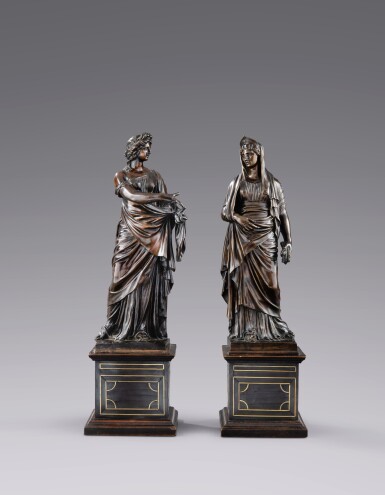Master Sculpture & Works of Art
Master Sculpture & Works of Art

Property from a Swiss Private Collection
Attributed to François Anguier (Eu 1604–1669 Paris), circa 1650
Allegorical Figures of Ceres and Arithmetic
Auction Closed
February 2, 05:19 PM GMT
Estimate
40,000 - 60,000 USD
Lot Details
Description
Property from a Swiss Private Collection
Attributed to François Anguier (Eu 1604–1669 Paris)
circa 1650
Allegorical Figures of Ceres and Arithmetic
bronze
height: 21 ⅝ in.; 55 cm.
Private Collection, France.
François Anguier is the younger brother of the better-known Michel Anguier. This imbalance of fame is perhaps due to the fact that François’s work is predominantly monumental. Therefore, the proposed attribution of this pair of bronzes provides and intriguing insight into the type of small bronze he may have produced.
Both Michel and François Anguier are credited with introducing Roman Baroque influences into French sculpture of the mid-17th century. Sometime before 1640 François stayed in Italy for two years. His sculptural style was aligned with the more classical works of Alessandro Algardi and François Duquesnoy than the flamboyant Baroque of Bernini. Back in France, by the end of the decade François is documented as sculpteur ordinaire du roi and resident in the Tuileries, indicating that his career as a sculptor of prestigious monuments was already well established. These include the tomb of Jacques-Auguste de Thou originally for St André-des-Arts, Paris (1640s, now in the Louvre), the tomb of Henri, Duc de Montmorency for the Chapel of the Convent of the Visitation at Moulins (1649-52, now Lycée Banville), the tomb of Henri Chabot, Duc de Rohan for the Célestins Convent in Paris (1655, now Versailles), the tomb of Jacques de Souvré for St-Jean de Latran, Paris (before 1677, now dispersed between Versailles, the Louvre and elsewhere) and, finally, the tomb of Henri Ier d’Orléans Ducs de Longueville et d’Estouteville, also originally in the Célestins (1663-9, now in the Louvre).
It is in a comparison with the latter monument to the Dukes of Longueville that the present two allegorical standing figures find their closest affinities in the work of François Anguier. The monument is composed of a obelisk with four life-size marble allegorical female figures, representing Justice, Temperance, Power and Prudence. Whilet taking into account the differences in scale and medium, the classical treatment of the drapery of these four Virtues is comparable to the diminutive pair of bronzes, notably in the manner in which the drapery falls in long folds onto the bases at the back of the figures. The drapery of the marble figures is more elaborate, following their more expressive poses, which may suggest that the bronze figures date to shortly after Anguier’s return from Rome when the lesson of Antique models such as the famous marble of Modesty in the Vatican (inv. 2284) or the monumental marble figure of Ceres, also in the Vatican (inv. 254), would have been fresh in his mind.
A particular characteristic of Anguier’s oeuvre is the attention he gives to the abundant hair of many of his tomb figures. Typical of this is his reclining figure of Jacques de Souvré on the terracotta model for the his Funerary monument which was sold at Versailles on 18 June 2023 (lot 179, Osenat, Commissaire-priseur) for €2,552,000 and is now in the Louvre. Jacques de Souvré’s voluminous and wavy hair falls over his shoulder in long spirals. This penchant for handling hair can also be observed in the bronze allegory of Arithmetic whose hair tumbles down her back in decidedly unclassical folds.
RELATED LITERATURE
P. Grimal, Dictionnaire de la mythologie grecque et romaine, Paris 1969, pp. 277-278;
J-R. Gaborit, Musée du Louvre. Sculpture française. II. Renaissance et temps modernes, Paris, RMN, vol. 2, 1998 ;
F. d La Moureyre, ”François Anguier (1604-1669): l'idea de bello” in Gazette des Beaux-Arts, September 2002, n° CXI, pp. 93-124 ;
A. Maral, François Girardon (1628-1715). Le sculpteur de Louis XIV. Suivi de l'etude François Girardon collectionneur par Françoise de La Moureyre, Paris, Athéna, 2016.
